Designer: Devereux Emmet (1917), Gil Hanse (2009, Restoration)
Location: East Setauket, New York
History: In early 1915, Devereux Emmet met with influential businessmen in New York City to find suitable land to build a golf course for his family and friends to use. Ultimately, they found a perfect site of rolling farmland on the middle of Long Island’s North Shore. St. George’s Golf & Country Club officially opened in June, 1917 to immediate acclaim. Unlike many of Emmet’s other courses, St. George’s design has stayed largely the same over the past century besides a restoration from Gil Hanse in recent years. Many consider St. George’s to be an underrated course, but a few publications hold it in high regard:
- #72 Best Classic Course in America – Golfweek (2023)
- #23 Best Course in New York – Golf Digest (2023)
- #19 Best Course in New York – Golf Magazine (2023)
- #18 Best Course in New York – Top100golfcourse.com (2020)
- #15 Best Private Course in New York – Golfweek (2023)
Conditions: 8/10, St. George’s is in strong condition with thick rough, well-manicured fairways, and true-rolling, bentgrass greens.
Value: N/A, This is a private course.
Scorecard:
Tee Par Yardage Rating Slope
Championship 70 6408 71.1 136
Blue 70 6232 70.5 133
Tournament 70 6016 69.7 130
White 70 5551 66.8 126
Red 71 5447 71.4 131
Red/Green 71 4939 69.1 126
Hole Descriptions: Devereux Emmet is a bit of an interesting architect and one I was excited to learn more about. The wealthy Emmet grew up in similar circles with C.B. Macdonald and was a prolific architect with over 150 courses to his name, including early versions of Garden City, Congressional, and Wee Burn. Unfortunately, many of his designs have been substantially altered over the years but that is not the case with St. George’s. Emmet accompanied Macdonald on his lengthy trip to Scotland studying architecture, and played an integral role in building National Golf Links of America. Despite his friendship with Macdonald, Emmet was a critic of template holes and a fierce competitor. If National was Macdonald’s home course and pinnacle, then so too is St. George’s for Emmet.
The first time you play St. George’s, it’s hard to control your excitement as you drive through the course on a busy public road and feast your eyes on the tremendous property from the clubhouse patio. This glorious view is thanks to Gil Hanse, who removed hundreds of trees and widened corridors. I was shocked at the land movement at St. George’s and can absolutely understand why Emmet chose this property after a long search for a course he’d call home. At just over 6400 yards from the Championship Tees, St. George’s isn’t the longest course but packs plenty of challenge with blind shots, quirky mounding, and a penal style of haphazard bunkering that reminds me a lot of Myopia Hunt’s. I wonder if Emmet was a slicer like his buddy Macdonald, as left is the worse miss on almost every hole at St. George’s. This is definitely a course that takes several rounds to get comfortable with and I look forward to getting back here sometime soon.
St. George’s opening hole is not the original opening hole (current day 12th), but I prefer today’s routing. At 374 yards, this hole features a blind teeshot to a fairway that doglegs left at about 230 yards. The aggressive golfer can cut the corner here, but OB lines the left while there’s plenty of room down the right. This approach plays over a valley to a back-to-front sloped green with a severe false front. Nicknamed “Sahara” because there used to be a giant bunker at the bottom of the swale, the only bunkers that remain are three deep ones on either side of the green.
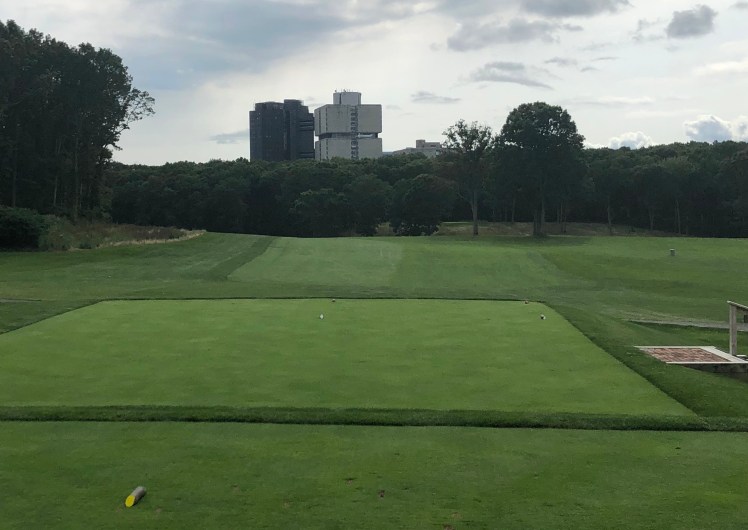

At a lengthy 574 yards, the number 1 handicap par 5 2nd hole is the longest hole at St. George’s. From the back teeboxes, this drive requires a mild forced carry over a valley to a fairway angled left. There used to be a bridge connecting the two and I’d love to see it brought back. This hole has been greatly enhanced by tree removal, and this fairway is actually contiguous with the 1st and 18th. The most noteworthy feature of this hole is the quirky hidden bunkers at the dogleg around 300 yards. These bunkers won’t be in play for most, but are highly memorable and penal. More scattered bunkers run down the right side of this fairway and three surround this large, relatively flat green.


The 3rd hole is an excellent 408 yard par 4 and one of my favorite holes at St. George’s. Featuring a completely blind, downhill teeshot, the golfer needs to be aware that rough encroaches down the right around 240 yards. With a steep downhill and right-to-left slope, the golfer often has to deal with a difficult lie on this downhill approach. A narrow, coffin-like bunker runs down the left for the final 50 yards while four additional bunkers surround this green on all sides but the front.


After crossing Lower Sheep Pasture Road, you arrive at another memorable hole in the 360 yard par 4 4th. A few in my group were not a fan of the road traversing through the course, but I was and imagine it was even better in a time of horse-drawn carriages. Although Emmet was not a fan of templates, this is almost certainly an Alps hole playing uphill to a green guarded by a hidden bunker. This teeshot is again blind with no real danger besides hidden bunkers on the right at 200 yards. This approach is one of the most unique I’ve seen with two crossbunkers and mounding just short of the green. The first bunker is visible and rather shallow, but the hidden one directly in front of the green is extremely deep. This square, back-to-front sloped green also plays almost as a Short template, with a moat of narrow, deep bunkers surrounding all sides.



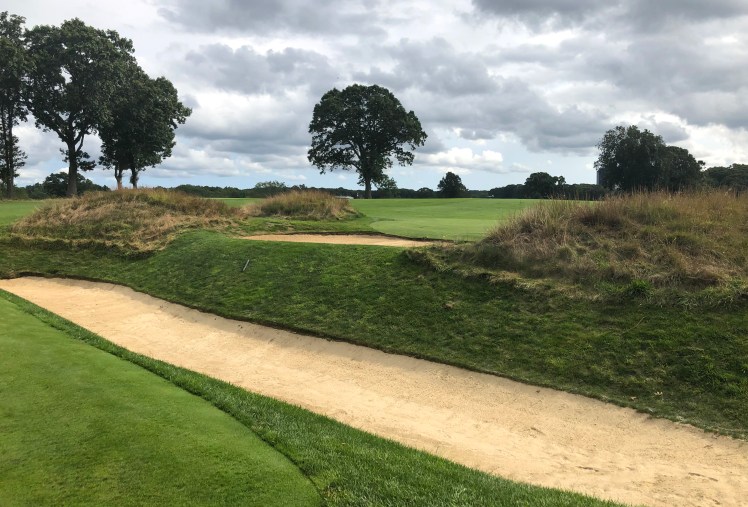
The 5th hole isn’t nearly as memorable as the first four, but it’s the first hole you can actually see the green from the teebox and this is appreciated. I can’t really get over the fact that this straightaway hole is named “Cape” but it might be Emmet’s penance after creating a template on the previous hole. At 356 yards, this par 4 features a tight fairway lined by series of bunkers and fescue on both sides starting at 220 yards. A lay-up leaves a short iron into a back-to-front sloped green lined by deep bunkers on either side.


At just 485 yards, the tight 6th hole is the shortest par 5 at St. George’s. This straightaway hole feels slightly claustrophobic with the 4th and 5th holes lining the right and OB on the left. This narrow fairway becomes almost nothing with an interesting trio of crossbunkers between 220 and 250 yards. While reachable in two, this blind approach is one of the more difficult on the course with a tall tree overhanging the left just a mere 20 yards short of the green. Wide, sweeping bunkers guard either side of this narrow, subtly undulating green. This is probably my least favorite hole on the course.

St. George’s features an unusual five par threes, but makes you wait until the 7th hole to play one. This is an excellent hole playing downhill at 181 yards. You can’t see much of the danger from the teebox, but a hidden crossbunker looms just short while additional bunkers guard long, left, and right of a well-protected green. A swirling wind makes for a difficult GIR.

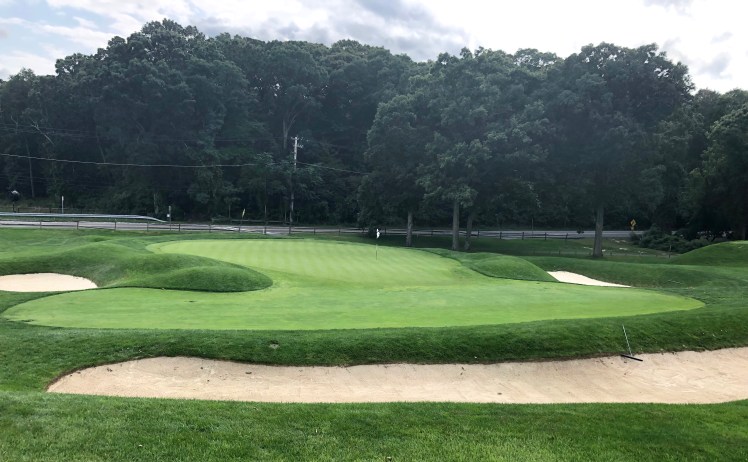
Playing back uphill, the 8th hole is another tester as a 382 yard par 4. This dogleg left features a blind teeshot to a wide fairway lined by golden fescue on both sides. Those who attempt to cut the corner need to carry several severe, wild bunkers hidden in the fescue. This approach plays level to a large green guarded by five narrow bunkers.


As is the case with many classic courses, the 9th hole is nowhere near the clubhouse at St. George’s. This short, but very sweet little 147 yard hole is tucked in the corner of the property and plays downhill with a small green. Those who miss this target will likely find one of two jaw-shaped bunkers that surround the front.

At 374 yards, the par 4 10th hole is another hole that features an open, blind teeshot. At about 275 yards, this fairway turns downhill and to the right with a large bunker and tree down the right. Like the fabulous 17th at Cape Arundel, this blind approach features a front-to-back sloped green with a significant downhill slope just short. Without local knowledge, this becomes a very difficult hole.
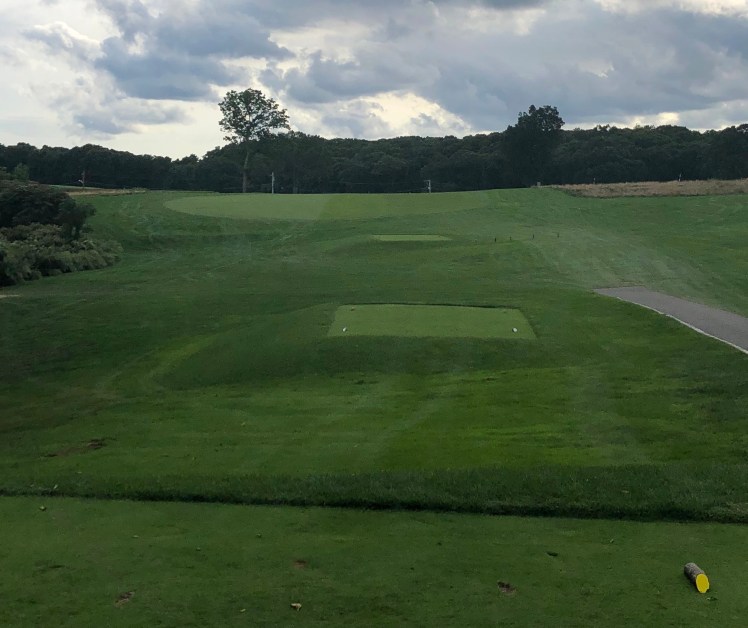

The 11th hole is the only hole on the course to change significantly from Emmet’s original design. For starters, this was the closing hole in 1917 and featured a carry over the road to green beyond the current one. At 246 yards, this par 3 must’ve been a monster and may have featured a Maiden green given the name of the hole. In 1951, a teebox was built on the other side of the road and the hole now plays 194 yards. Still difficult, this lengthy par 3 plays over a valley to an elevated left-to-right sloped green guarded by deep bunkers left, long, and right.

Originally the opening hole, the modern day 12th has been lengthened significantly and is now an imposing 420 yard par 4. Featuring a somewhat claustrophobic drive, this hole again contains OB down the left and thick fescue on both sides. The ideal drive utilizes the heavy right-to-left tilt of the fairway here. Two bunkers line just right of a large, subtly undulating green. While I am a fan of the hole, I would like to see more tree management, as trees short left of the green overhang and unfairly block some pin positions.
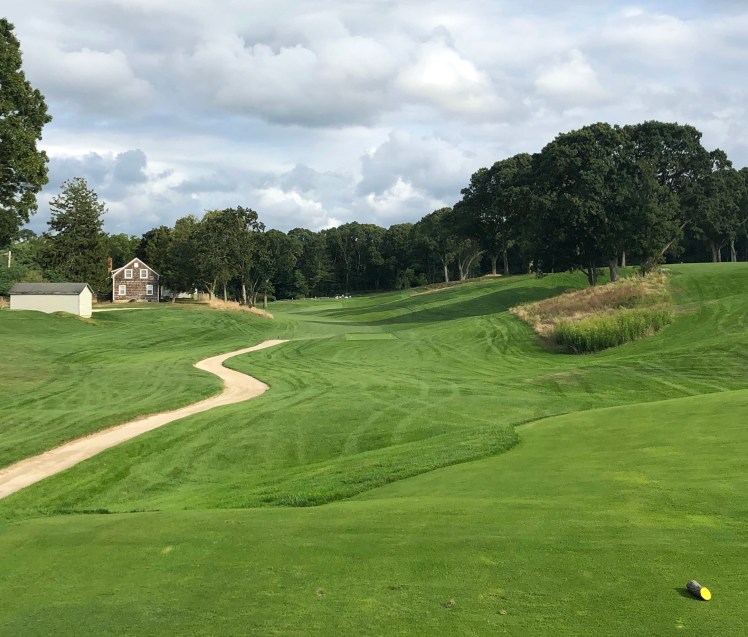
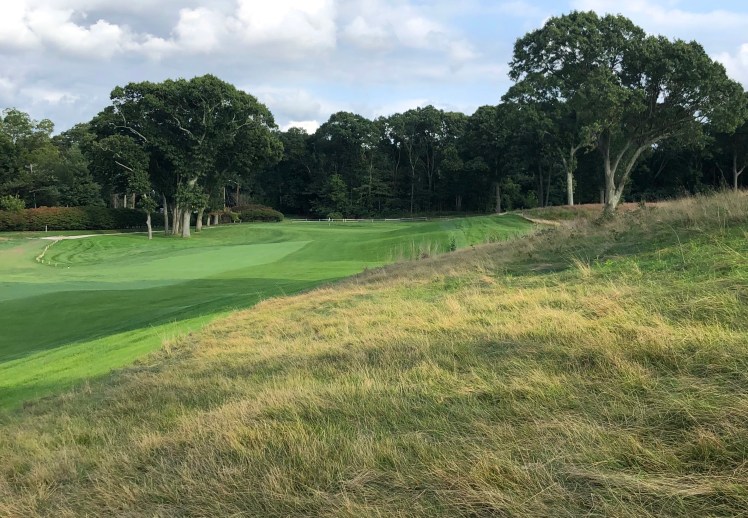
Running parallel to the preceding hole, the 13th hole is another beastly par 4 at 450 yards and the most difficult on the course in my opinion. This blind fairway is initially rather tight with trees on both sides, but opens up around 250 yards with a steep downhill, left-to-right slope. For those who venture left, a pond at 290 yards is reachable. Like so many others at St. George’s, this approach is blind until about 80 yards short of the green, when the fairway steeply slopes. The reveal from this apex is breathtaking, with a green sitting in a natural punchbowl and bunkers short on either side. With its length and recurrent blind shots, anything better than bogey here is an achievement.
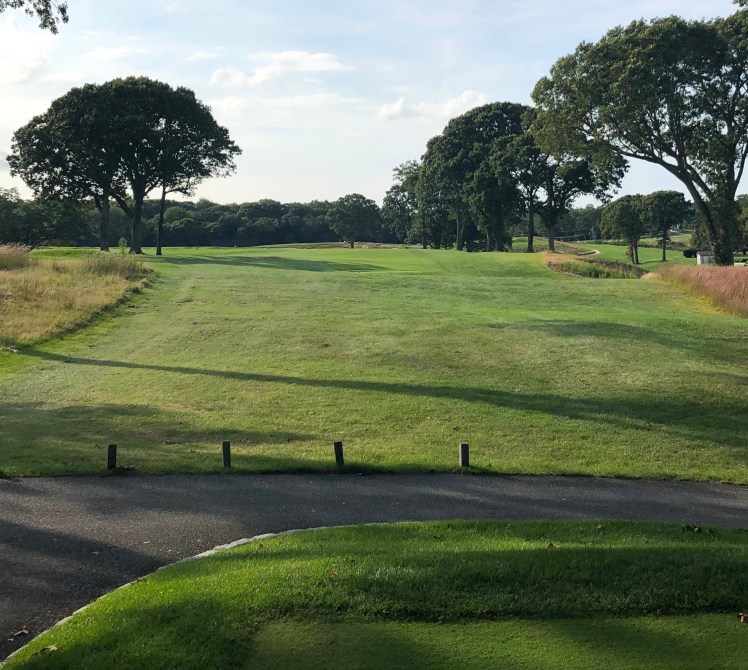


The view from the 14th teebox can be a bit disorienting the first time you play St. George’s. Because of the sprawling terrain laid out in front of you, the 14th appears less like an individual hole but more as a piece of amorphous land with a flagstick at the end. Roughly, the boundaries of this 388 yard par 4 are tall trees down the left at 270 yards and water down the right at 200 yards. Depending on your length, it’s certainly possible to play down the neighboring 13th and 16th holes here. This green is well-protected with six bunkers guarding all sides but the front.


The 15th hole is a gorgeous 164 yard par 3. Playing slightly downhill over fescue, this green appears readily attackable but features steep slopes on its sides and is surrounded by six bunkers.
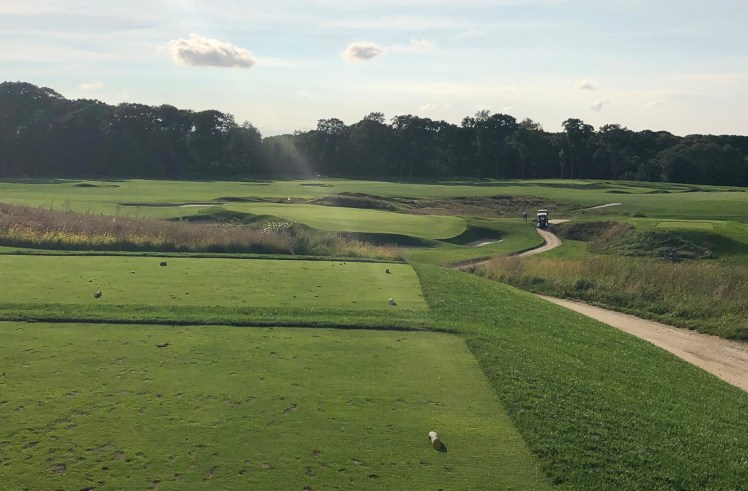
For many, the fascinating 16th is their favorite par 4 at St. George’s, but that’s not the case for me. At just 318 yards, this is the shortest par 4 on the course and certainly reachable for some. Nicknamed “Water Kelpie” for a small pond directly in front of the teebox, this hole’s fairway turns right as soon as you cross the pond. Interestingly, the direct line to the green must play over a giant tree which I am not a fan of. Those who elect to play down the left need to beware of five church-pew inspired bunkers between 190 and 250 yards. The smallest green on the course features a severe false front and bunkers left.


My favorite thing about St. George’s is how unique and memorable so many of its holes are. There are none more impressive than the signature par 3 17th. At just 122 yards, this terrifying little hole is certainly one of the best short par threes I’ve seen. Just like the famous “2 or 20” hole at Engineers or 3rd at Wannamoisett, any miss here can lead to a big number. While not officially the smallest green on the course, a significant back-to-front slope and false front make this green functionally a fraction of its actual size. Deep bunkers surround all sides, with an especially notorious pair short.
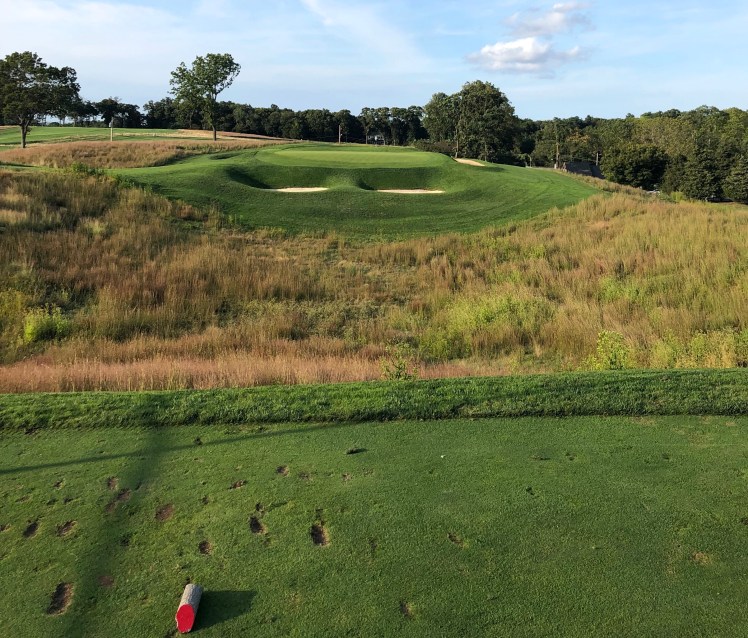

St. George’s saves another fantastic hole for last with an epic 535 yard par 5 returning to the clubhouse. It’s not readily evident from the teebox, but this is one of the most bunkered holes I’ve ever played. Because this fairway is contiguous with the 2nd and 16th, however, there’s plenty of short grass available. At about 290 yards, this fairway turns sharply left with a tremendous “Hell’s half-acre” hazard beginning down the left. With over ten gnarly bunkers and thick Long Island fescue, it’s imperative you stay right on your lay-up. This green is one of the largest on the course and features two tiers that slope back-to-front. While open in front, a total of seven bunkers guard left, long, and right.


General Comments: The practice facilities at St. George’s are strong with a full range that narrows with distance, a large putting green, and a strange short game area that seems like it was part of an old hole.

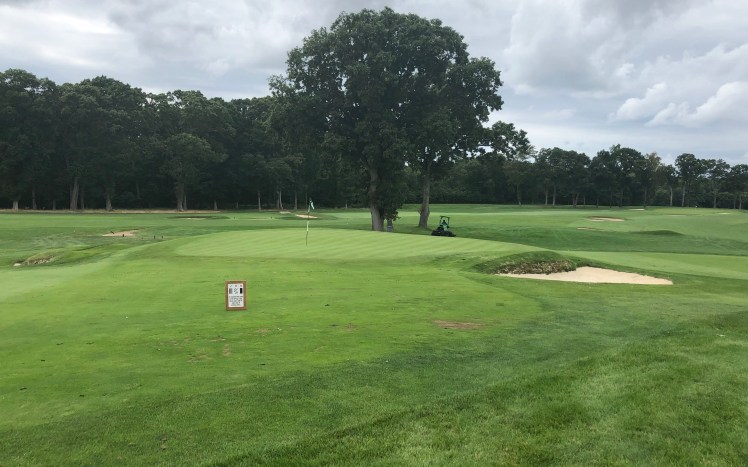
After two devastating fires, St. George’s fourth clubhouse feels very much like a home. As mentioned above, the patio offers an expansive view of much of the course and is a perfect place to enjoy a cocktail. Pace of play was excellent on a weekday afternoon.

Verdict: Located on the middle of Long Island’s North Shore, St. George’s doesn’t get the national recognition many of its neighbors do, but should not be overlooked. An untouched Devereux Emmet gem, this quirky layout features several world-class holes and some of the most fascinating architecture in America.